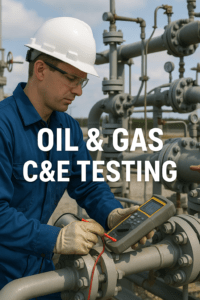
🛡️ Oil & Gas C&E Testing That Saves Lives: What Every Engineer Must Know
Oil & Gas C&E Testing: Why It’s Vital for Safe Commissioning
In oil and gas commissioning, Cause and Effect (C&E) Testing is a mission-critical milestone for validating control system logic and ensuring safe start-up. By confirming that safety systems respond correctly to defined input events, C&E Testing helps prevent hazardous incidents and supports regulatory compliance.
As industrial facilities become increasingly automated, thorough C&E Testing isn’t optional—it’s the final safeguard before go-live.
🔍 Why Oil & Gas C&E Testing Is Essential
Oil & Gas C&E Testing confirms that every input (cause)—like gas detection, fire alarms, or system trips—produces the correct output (effect), such as triggering shutdowns, isolations, or alarms. These logic links are defined in Cause & Effect Charts, usually developed from HAZOP, LOPA, and SIL studies.
This type of testing ensures:
- Emergency Shutdown (ESD) systems operate correctly
- Fire & Gas Systems (FGS) trigger alarms and mitigation
- Utility and process interlocks engage as designed
- HVAC systems isolate air handling upon smoke detection
- Equipment protection logics prevent damage
🔗 Explore our Commissioning Services to learn how we support structured and safe start-up processes.
🧪 Oil & Gas C&E Testing Methodology
C&E Testing aligns with global safety standards like:
- IEC 61511 – Functional safety for SIS
- API RP 14C – Offshore safety systems
- OGP Report 476 – Systematic commissioning approaches
Key components include:
- Logic Matrices – Maps input causes to expected responses
- Test Scripts – Step-by-step verification with pass/fail results
- Live Monitoring – DCS/SCADA observation during test execution
- Re-test Protocols – Defined corrective steps for failures
💡 Pro tip: Maintain traceable documentation for all test logs and sign-offs to satisfy auditors and clients.
📋 Planning Effective Oil & Gas C&E Testing
Successful C&E Testing begins during the design and pre-commissioning phases. Best practices include:
- Reviewing and approving all Cause & Effect Charts
- Ensuring all field instruments are calibrated
- Confirming SIS, PLC, and DCS readiness
- Creating a detailed pre-commissioning checklist
- Engaging HSE teams early for safety oversight
🔗 Review our HSE Methodology to see how we integrate safety across commissioning phases.
⚠️ Common C&E Testing Pitfalls to Avoid
Even experienced teams face these frequent issues:
- Outdated logic diagrams
- Incomplete test scripts
- Unclear BPCS–SIS interface design
- Lack of isolation procedures
- Inadequate coordination across disciplines
Avoiding these requires experienced leadership, validated documentation, and real-time communication during testing.
🛠️ Modern Tools in C&E Testing for Oil & Gas
Emerging technologies are transforming C&E Testing:
- Digital Twins – Virtual systems simulate real-time behaviour
- Remote Witnessing – Third-party validation via live video
- Cloud-Based Logs – Auto-save all test results and comments
- SCADA Trending – Monitor and verify outputs over time
🌐 Discover how Digital Twins are reshaping commissioning (external resource).
🦺 HSE in Focus: Safety-First C&E Testing
Live testing carries inherent risks. Proper HSE controls are non-negotiable:
- Permit to Work (PTW) systems
- Verified electrical and mechanical isolations
- Real-time gas monitoring
- Emergency readiness plans
- On-site HSE observers and witnesses
🔗 Learn how Sixfoldgroup embeds HSE into all commissioning projects.
❓ Frequently Asked Questions (FAQ)
What is Oil & Gas C&E Testing?
It’s a structured process to validate that specific inputs (e.g., gas detection) trigger the correct automated system responses (e.g., shutdown, alarm), per safety design.
Is C&E Testing required before start-up?
Yes. For compliance with standards like IEC 61511 and API RP 14C, C&E Testing is mandatory before systems go live.
Who performs C&E Testing?
A multidisciplinary team: commissioning engineers, automation specialists, control system vendors, and HSE personnel.
How long does C&E Testing take?
It depends on system complexity. A large oil and gas project may involve thousands of test points over weeks.
Can any parts be automated?
Yes—simulation, data logging, and reporting can be automated, but human verification remains essential for safety-critical systems.
✅ Quick C&E Testing Readiness Checklist
- 🔲 Approved Cause & Effect Charts
- 🔲 Instrument loops are fully calibrated
- 🔲 DCS/PLC logic implemented and reviewed
- 🔲 Test procedures signed off
- 🔲 HSE plans validated for live testing
- 🔲 Remote access tools set (if used)
- 🔲 Test logs structured for audit readiness
🚀 Ready to Commission Safely?
Oil & Gas C&E Testing is your last line of defence. It ensures that all automated safety responses work exactly as designed—before operators take control. At Sixfoldgroup, we bring expert leadership, proven tools, and compliant workflows to every commissioning project.
👉 See our CxA Commissioning Services to discover how we support safe and structured facility start-ups across oil and gas.

